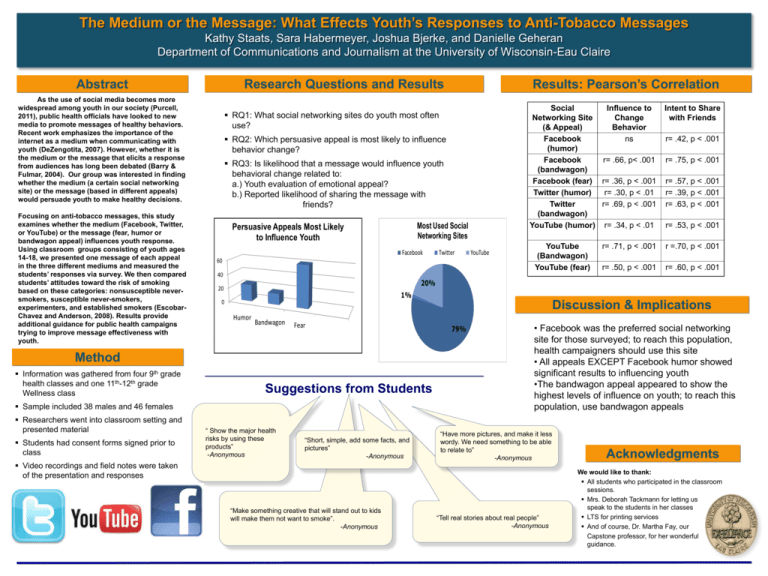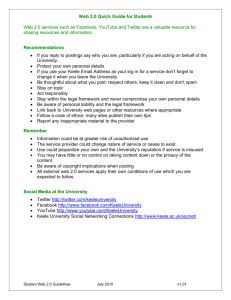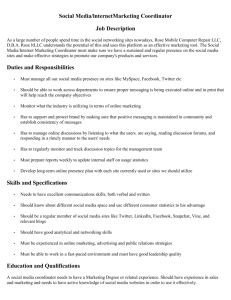StaatsSpr11
advertisement

The Medium or the Message: What Effects Youth’s Responses to Anti-Tobacco Messages Kathy Staats, Sara Habermeyer, Joshua Bjerke, and Danielle Geheran Department of Communications and Journalism at the University of Wisconsin-Eau Claire As the use of social media becomes more widespread among youth in our society (Purcell, 2011), public health officials have looked to new media to promote messages of healthy behaviors. Recent work emphasizes the importance of the internet as a medium when communicating with youth (DeZengotita, 2007). However, whether it is the medium or the message that elicits a response from audiences has long been debated (Barry & Fulmar, 2004). Our group was interested in finding whether the medium (a certain social networking site) or the message (based in different appeals) would persuade youth to make healthy decisions. Focusing on anti-tobacco messages, this study examines whether the medium (Facebook, Twitter, or YouTube) or the message (fear, humor or bandwagon appeal) influences youth response. Using classroom groups consisting of youth ages 14-18, we presented one message of each appeal in the three different mediums and measured the students’ responses via survey. We then compared students’ attitudes toward the risk of smoking based on these categories: nonsusceptible neversmokers, susceptible never-smokers, experimenters, and established smokers (EscobarChavez and Anderson, 2008). Results provide additional guidance for public health campaigns trying to improve message effectiveness with youth. RQ2: Which persuasive appeal is most likely to influence behavior change? RQ3: Is likelihood that a message would influence youth behavioral change related to: a.) Youth evaluation of emotional appeal? b.) Reported likelihood of sharing the message with friends? Most Used Social Networking Sites Persuasive Appeals Most Likely to Influence Youth Facebook Students had consent forms signed prior to class Twitter 60 40 YouTube YouTube (Bandwagon) YouTube (fear) Intent to Share with Friends r= .42, p < .001 r= .75, p < .001 r= .57, p < .001 r= .39, p < .001 r= .63, p < .001 r= .53, p < .001 r= .71, p < .001 r =.70, p < .001 r= .50, p < .001 r= .60, p < .001 20% 20 1% 0 Discussion & Implications Humor Bandwagon Fear Suggestions from Students Sample included 38 males and 46 females Researchers went into classroom setting and presented material Social Influence to Networking Site Change (& Appeal) Behavior Facebook ns (humor) Facebook r= .66, p< .001 (bandwagon) Facebook (fear) r= .36, p < .001 Twitter (humor) r= .30, p < .01 Twitter r= .69, p < .001 (bandwagon) YouTube (humor) r= .34, p < .01 RQ1: What social networking sites do youth most often use? Method Information was gathered from four 9th grade health classes and one 11th-12th grade Wellness class Results: Pearson’s Correlation Research Questions and Results Abstract “ Show the major health risks by using these products” -Anonymous “Short, simple, add some facts, and pictures” -Anonymous Video recordings and field notes were taken of the presentation and responses “Make something creative that will stand out to kids will make them not want to smoke”. -Anonymous 79% • Facebook was the preferred social networking site for those surveyed; to reach this population, health campaigners should use this site • All appeals EXCEPT Facebook humor showed significant results to influencing youth •The bandwagon appeal appeared to show the highest levels of influence on youth; to reach this population, use bandwagon appeals “Have more pictures, and make it less wordy. We need something to be able to relate to” -Anonymous “Tell real stories about real people” -Anonymous Acknowledgments We would like to thank: All students who participated in the classroom sessions. Mrs. Deborah Tackmann for letting us speak to the students in her classes LTS for printing services And of course, Dr. Martha Fay, our Capstone professor, for her wonderful guidance.




